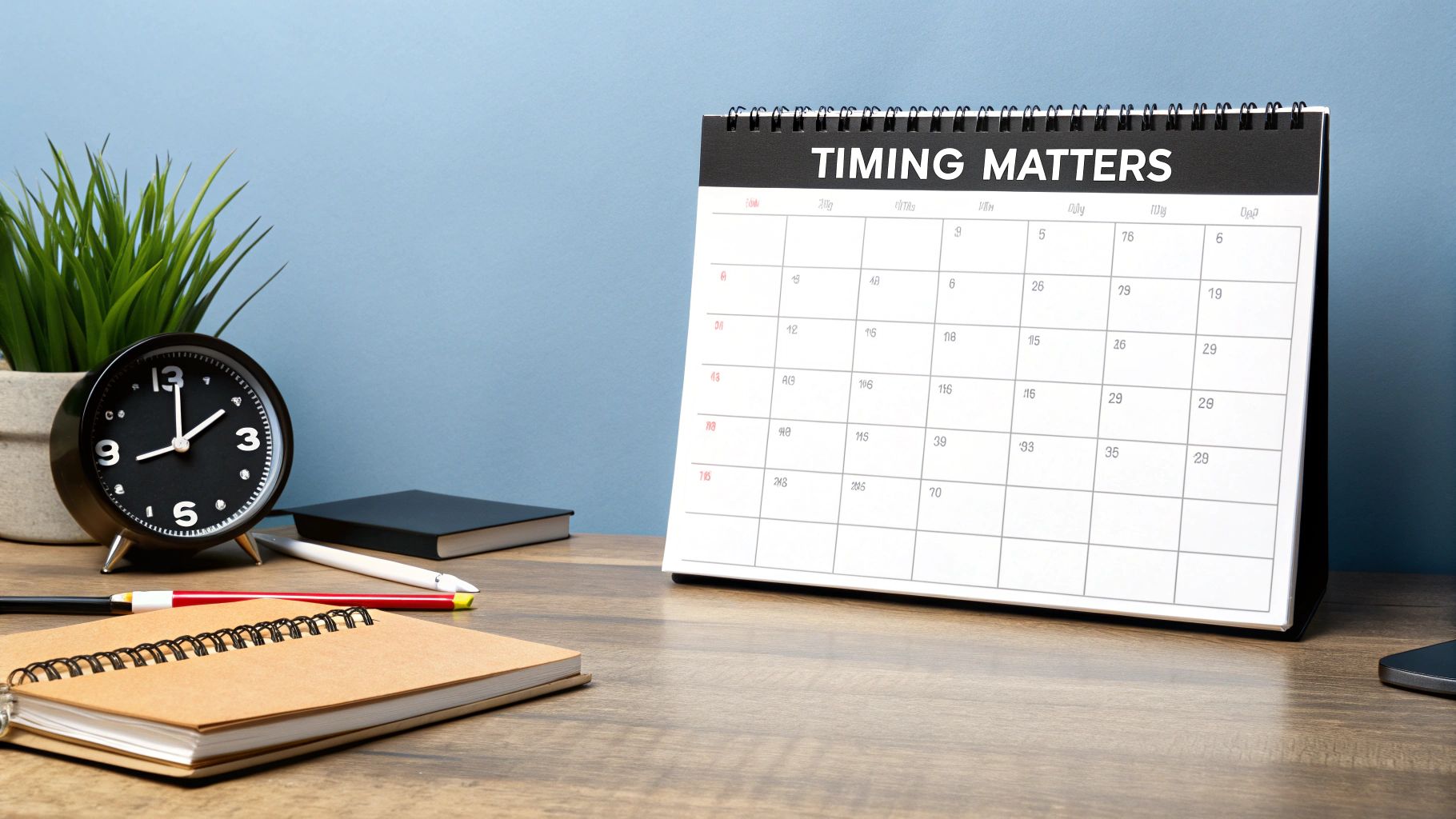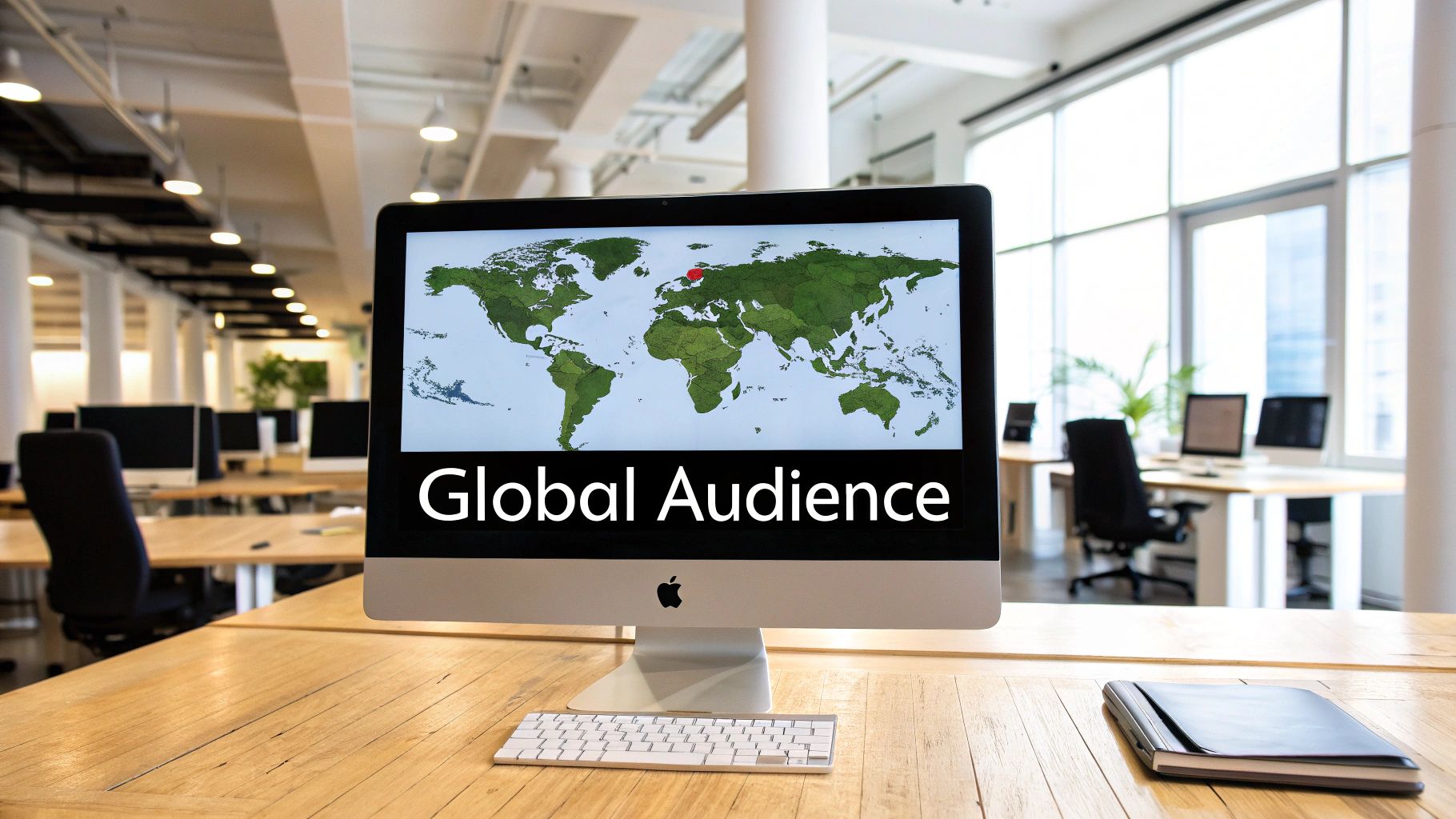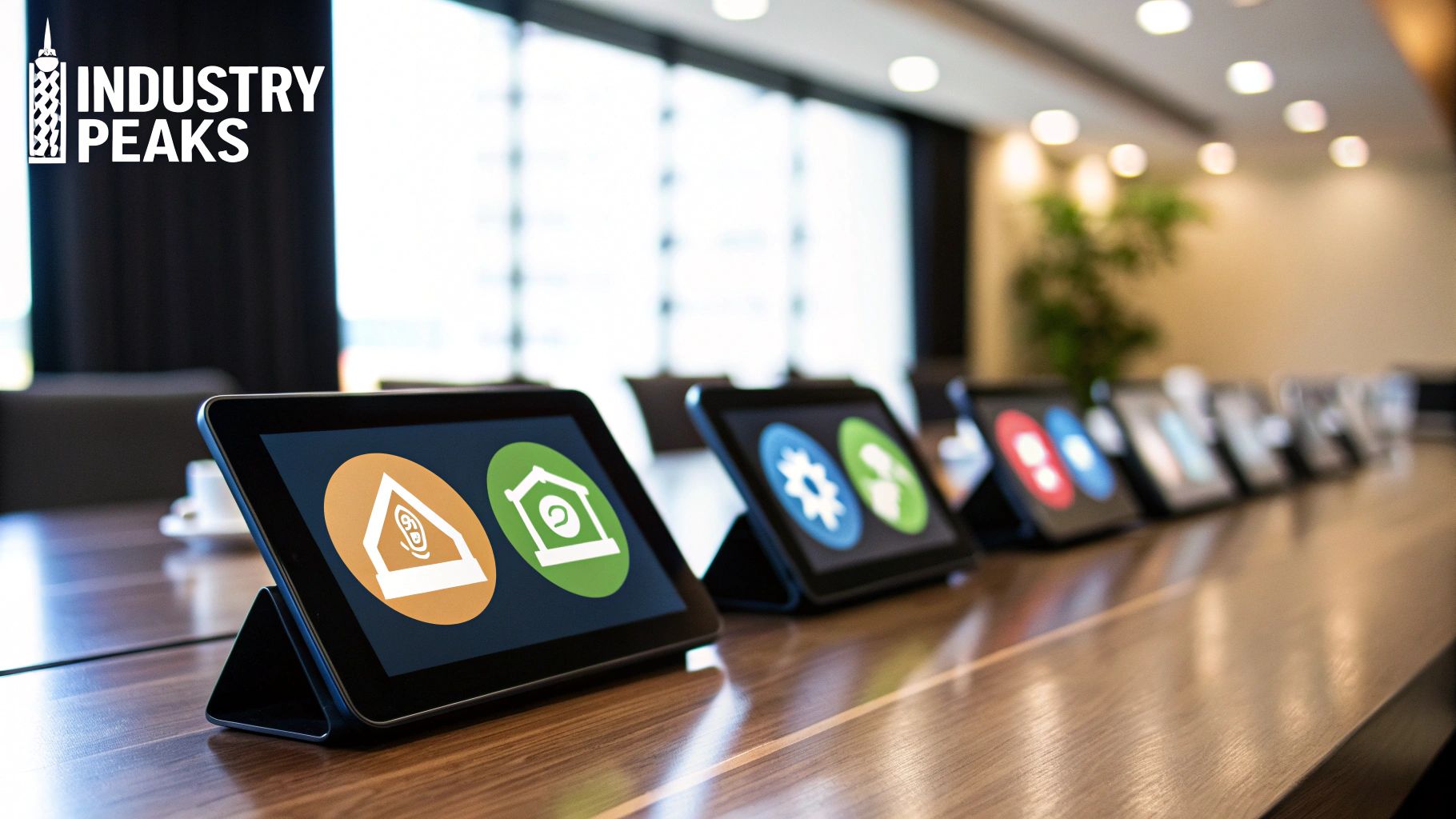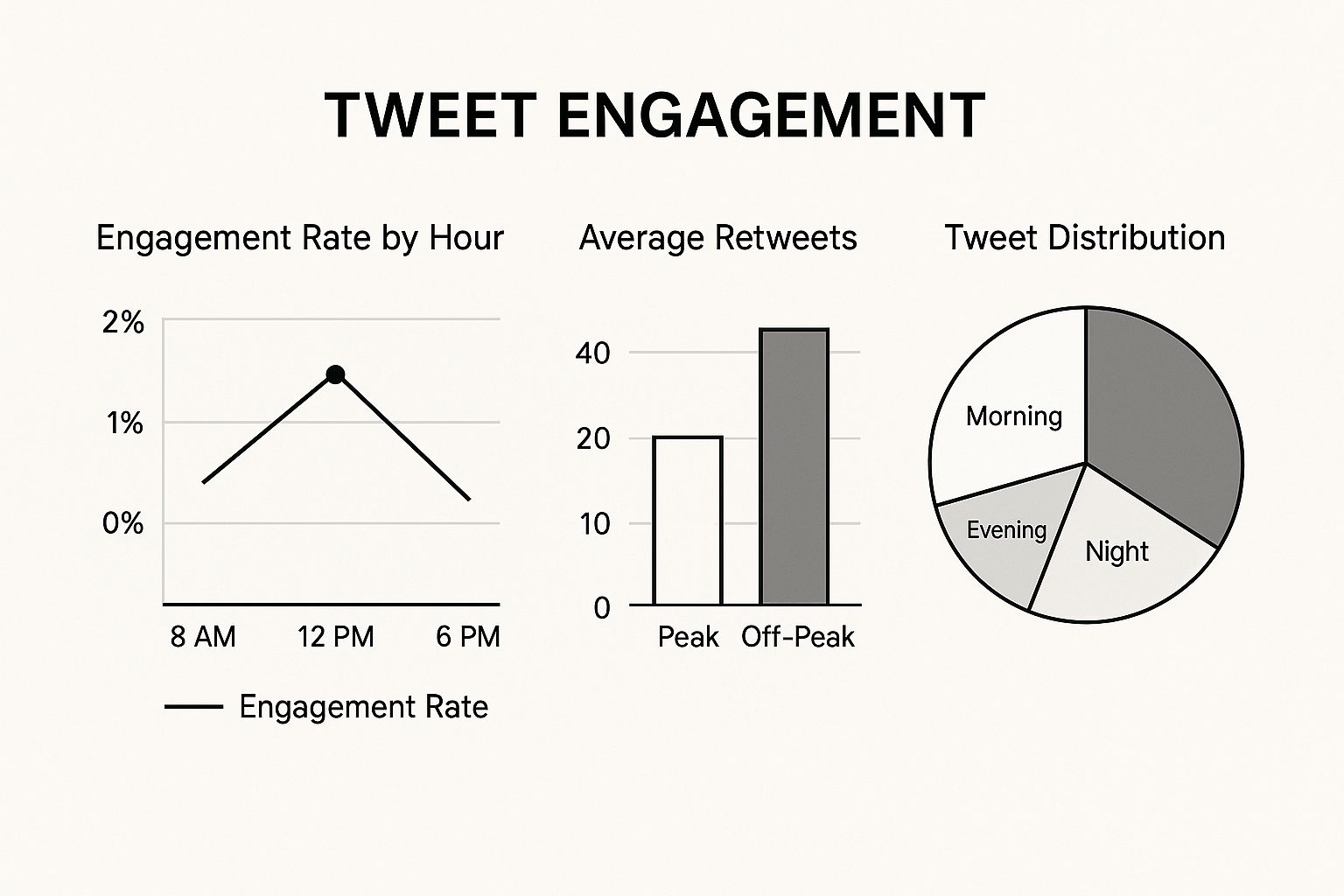Everyone wants to know the secret—the one magic hour to post a tweet that guarantees a tidal wave of likes and retweets. The bad news? It's a myth. The good news? The real answer is far more powerful.
Beyond the Myth of a Single Best Time to Tweet

In a world with global audiences, dozens of time zones, and algorithms that change on a whim, a one-size-fits-all schedule is a recipe for disappointment. The key isn't finding a universal "best time" but discovering the unique digital rhythm of your own followers.
Think of yourself as a radio DJ. You wouldn't play the biggest hits at 3 AM when your listeners are fast asleep. You save them for the morning commute or the lunch hour rush. Your goal on Twitter (X) is the same: share your best content when your audience is most likely to be scrolling, engaged, and ready to jump into the conversation.
Start with General Guidelines
While a custom-tailored schedule is the ultimate prize, you have to start somewhere. Broad industry data gives you a solid foundation to build upon and a place to begin your experiments.
With over 500 million tweets flying out every single day, the fight for attention is real. Luckily, analysis from thousands of accounts has done some of the legwork. The data consistently shows that weekdays, especially Tuesday through Thursday, tend to see the highest engagement, typically between 9 AM and 1 PM PST. You can dig deeper into how these insights are derived from platform data on meetassembly.com.
This baseline gives you a strategic place to start while you gather your own, more valuable data.
The most effective tweeting strategy is a blend of broad best practices and hyper-specific audience analytics. Start with what works for most, then refine it to what works best for you.
To get you started, here's a quick look at the generally accepted peak engagement windows. Think of these as your initial test slots before you start fine-tuning based on your own analytics.
General Peak Engagement Windows for Twitter (X)
This table summarizes the high-engagement times that work for a wide range of accounts. Use these as a starting point for your scheduling strategy, and remember that all times should be considered local to your primary audience.
| Day of the Week | High-Engagement Time Window | Notes |
|---|---|---|
| Monday | 10 AM - 12 PM | Start the week strong as people catch up after the weekend. |
| Tuesday | 9 AM - 2 PM | Often a high-engagement day as work routines are in full swing. |
| Wednesday | 9 AM - 3 PM | The peak of the week for many industries and audiences. |
| Thursday | 9 AM - 2 PM | Engagement remains high before the pre-weekend slowdown. |
| Friday | 9 AM - 1 PM | Attention starts to drop off as the weekend approaches. |
| Weekend | 9 AM - 12 PM | Generally lower engagement, but can work for specific niches. |
Treat these windows not as rigid rules but as your first set of hypotheses. Now, you can start posting within these times and watch your own data to see what truly resonates with your followers.
Discovering Your Audience's Digital Rhythm

Those general engagement windows are a fine place to start. But the real secret to nailing the perfect time to tweet is to stop looking at the crowd and start focusing on your specific audience.
Think of it like being a radio DJ. You don't just play music when most people are in their cars; you play it when your listeners are tuned in. Your followers have their own unique online habits, a kind of digital rhythm, and your job is to find that beat.
This means you have to go deeper than generic advice. It’s not just about their age or industry, but about their daily digital lives. When do they grab their phones? Are they early birds scrolling over coffee or night owls doing one last check before bed?
Mapping Your Audience's Timeline
First things first: where in the world are your followers? If you've got a global audience, posting at "9 AM" is pretty much meaningless. A tweet timed for London will be completely missed by your followers in Tokyo.
A simple way to start is by looking at the locations people list in their bios. You can also use analytics tools that give you a geographic breakdown of your audience. Pinpointing your top three to five time zones is a massive first step toward building a smarter schedule.
Once you know this, you can time your most important content to hit peak hours in different regions. No more shouting into the void. If you want to really dig into this, our guide on the best times to tweet has more strategies for managing a global audience.
Building Your Audience Persona
Knowing where your followers are is half the battle. Now you need to understand who they are and what a typical day looks like for them. This is where you build an audience persona—a semi-fictional character based on your ideal follower.
An effective audience persona goes beyond simple demographics. It maps out a "day in the life," identifying key moments when your followers are most likely to be online and receptive to your content.
A developer in San Francisco and a marketing manager in Berlin have wildly different daily schedules. It’s your job to know them.
- The Developer (PST): Probably checks Twitter on the morning commute (8-9 AM PST), scrolls during their lunch break (12-1 PM PST), and unwinds with a final scroll after a long day of coding (8-10 PM PST).
- The Marketing Manager (CET): Likely catches up on industry news first thing (9-10 AM CET), looks for trends over lunch (1-2 PM CET), and joins professional chats in the late afternoon (4-5 PM CET).
When you build out these detailed personas, you stop guessing and start anticipating. Your scheduling transforms from a game of chance into a calculated strategy built on real human behavior.
Using Analytics to Find Your Engagement Sweet Spot
Guesswork will only take you so far. While general timing advice gives you a decent starting point, the real magic happens when you dig into your own data. It’s time to stop throwing content at the wall and start making decisions based on your account's unique engagement patterns.
Think of it like using a generic city map versus a real-time GPS. The map shows you the main roads, but your GPS analyzes live traffic to find the absolute fastest route for you. X Analytics (what used to be Twitter Analytics) is your personal GPS for finding the perfect time to tweet.
Navigating Your Analytics Dashboard
Your analytics dashboard is where all those raw numbers get turned into something you can actually use. It doesn't just show you what content resonates with your audience, but when it hits the hardest. Don't let yourself get overwhelmed by all the data—just focus on a few key metrics that tell a clear story.
The main overview page is your mission control. It gives you that high-level summary of your account's performance, showing you things like total impressions and your overall engagement rate. It's the quickest way to see the direct results of your posting strategy.
From there, you'll want to check out the "Top Tweets" section. This is crucial for connecting your post timing with its performance.

This view lets you see exactly which tweets pulled in the most impressions and engagement, helping you spot the patterns between your best-performing content and when you published it.
Connecting the Dots for Better Timing
Once you've found your way around the dashboard, the real work begins: connecting the dots. Your goal is to find clear correlations between the time you post and the engagement you get back. A great place to start is by exporting your tweet activity data for the last month.
Your past performance is the most reliable predictor of future success. Analyzing your own data removes speculation and replaces it with evidence, showing you exactly when your audience is most receptive.
Start looking for trends by asking yourself a few simple questions:
- What day consistently gets the highest engagement? Go through your top-performing tweets. Do you see a lot of them landing on Tuesdays or Thursdays?
- What time of day are my followers most active? Check the publish times of your most popular posts. Are they all clustered in the morning, or do they perform better in the early afternoon?
- Does my engagement rate change with different content types? Compare how well links, images, and text-only tweets do when posted at different times of the day.
If you want to get more dynamic insights into your audience's activity, exploring how AI-powered real-time social media analytics can give you the data you need to fine-tune your timing even further.
Remember, this process isn't about finding one single "perfect" hour to post. It's about identifying several high-potential "sweet spots" where your content is most likely to take off. Use this information to build a smarter, more effective posting schedule.
Advanced Scheduling Strategies That Outsmart the Crowd
Once you’ve got a handle on your audience’s daily habits, it’s time to graduate from the basics. Just posting at peak hours is like showing up to a party when it’s already packed—you’re just adding to the noise. The real pros know how to get there early and make an entrance.
A killer tactic is front-running the peak. Instead of dropping your biggest tweet right at 10 AM with everyone else, try posting 30 to 60 minutes beforehand. This gives your content a crucial head start, letting it pick up steam with the early birds before the main timeline rush begins.
The X algorithm loves tweets that get instant engagement—likes, replies, and retweets are its fuel. By front-running, you kickstart that feedback loop while your competition is still queuing up. You can see a great breakdown of how early engagement impacts tweet visibility on tweetpeek.ai.
Matching Content Type to Timing
Not all content hits the same, so why would you post it at the same time? A truly sharp strategy doesn't just have one "best time to post." It has several, each perfectly matched to a specific type of content and what your audience is doing at that moment.
Think about building a content calendar that maps your formats to the times they’re most likely to land.
- Morning (8 AM - 11 AM): People are scrolling for quick hits while sipping their coffee. This is your window for news, industry updates, and motivational quotes. Keep it scannable and valuable.
- Midday (12 PM - 3 PM): The lunch break is when people are more inclined to interact. Fire off your questions, run some polls, or share behind-the-scenes content that invites a reply.
- Evening (6 PM - 9 PM): Attention spans get longer as people unwind. Now’s the time for your heavy hitters: in-depth threads, long-form videos, and big-idea pieces that need more than a glance to appreciate.
Building a Predictable Content Rhythm
Posting great content at the right time is good. Doing it consistently is what builds a loyal following. When people know to expect your killer thread every Tuesday evening, they stop just scrolling past and start actively looking for it.
Consistency turns passive scrollers into an active community. By showing up at predictable times with valuable content, you train your audience to look forward to your posts, making your timing strategy even more powerful.
Pulling this off consistently often means looking into marketing automation solutions that handle the scheduling grunt work, freeing you up to focus on creating content that connects.
Ultimately, mastering your timing is about building a reliable rhythm. It turns scheduling from a chore into a core part of your community-building strategy. And if you're looking to get that process locked down, our guide on how to schedule social media posts has everything you need. This is how you make sure your best work always finds its audience, right on time.
Tailoring Your Tweet Times for Different Industries
A one-size-fits-all posting time is a decent starting point, but it misses a critical piece of the puzzle: the audience for a B2B tech company acts completely differently than the followers of a fast-food chain. To find the optimal time to tweet for your account, you have to move beyond broad advice and tune into the unique digital pulse of your industry.
Think about it—the daily rhythm of a healthcare professional is nothing like that of a retail shopper. One might be scrolling for industry news before a 6 AM shift, while the other is browsing for deals during their lunch break. To actually connect, you have to show up in these distinct moments of attention.
Shifting Peaks B2B vs B2C Audiences
For business-to-business (B2B) brands, engagement almost always lines up with the traditional workday. Their audience is most active when they’re at their desks, hunting for professional insights and industry updates. This means the sweet spots are usually concentrated during weekday business hours, from mid-morning to early afternoon.
On the flip side, business-to-consumer (B2C) brands often strike gold outside these hours. Their audiences are far more likely to engage during commutes, lunch breaks, and in the evening. Weekends, which are often a ghost town for B2B, can be a goldmine for retail, entertainment, and hospitality brands looking to capture attention during leisure time.
Industry-Specific Timing Examples
Let’s break down how this actually works for different fields:
- Financial Services: Engagement in this sector tends to spike early on weekday mornings. This is when professionals are catching up on market news before their day officially kicks off.
- Retail and E-commerce: These brands see a big lift during midday lunch hours (11 AM - 2 PM) and again in the evening as people unwind and shop from their couches.
- Travel and Hospitality: Engagement often surges around noon on Sundays. This timing catches people right as they're planning new trips or coming back from weekend getaways, making them super receptive to travel content.
This is all about aligning with your audience’s real-world schedule. The following table gives a few more examples of how different industries might approach their timing strategy.
Sample Tweet Timing Strategies by Industry
| Industry/Niche | Primary Audience | Likely Peak Times | Content Focus |
|---|---|---|---|
| B2B SaaS | Tech professionals, executives | Weekdays 10 AM - 3 PM | Industry insights, product updates, case studies |
| Healthcare | Medical professionals, patients | Early mornings (6-8 AM), evenings | Health tips, research news, community stories |
| Food & Beverage | General consumers | Lunchtime (12-2 PM), evenings (6-8 PM) | Promotions, new menu items, user-generated content |
| Entertainment | Fans, general public | Evenings (7-10 PM), weekends | Trailers, behind-the-scenes content, fan engagement |
Of course, these are just starting points. The real magic happens when you combine these general guidelines with your own data.
This infographic really drives home how much engagement can shift throughout the day and why timing matters for more than just views.

As you can see, posting during those peak hours doesn't just get you more eyeballs; it dramatically boosts interaction, leading to more retweets and replies.
While industry trends provide a powerful framework, remember that every audience is unique. Use this as your strategic hypothesis, then let your own analytics confirm the perfect timing for your brand.
Even with all these industry variations, some universal patterns still emerge. Multiple analyses point to 9 AM on Wednesday as a major global peak, with early weekday mornings around 8 or 9 AM also showing consistently strong results. This lines up perfectly with the habits of Twitter's core user base, who often check the platform right before their workday begins. You can dig into more of the data behind these peak global times on buffer.com.
Building Your Data-Driven Tweeting Schedule
Alright, let's put all this theory into practice. Finding your "golden hours" to tweet isn't about finding a magic bullet; it's an ongoing cycle of testing, learning, and tweaking your approach. This is where you move from reading about strategy to actually building one that gets results.
The end game is a sustainable schedule that you can rely on to drive real engagement. Here’s a simple, four-step checklist to build and refine your tweeting schedule from the ground up.
Your Four-Step Implementation Plan
Establish Your Baseline: First, start by scheduling tweets during those generally accepted peak times. For most brands, that’s weekdays between 9 AM and 3 PM. Think of this as your starting hypothesis—a solid, educated guess to get the ball rolling.
Analyze Your Own Data: After a couple of weeks, it's time to dig into your X Analytics. Export your tweet activity and start hunting for patterns. Are there specific days or times that consistently bring in the highest impressions and engagement? Your own data will always be your most reliable source of truth.
A/B Test Your Time Slots: Now for the fun part: experimentation. If your data shows Wednesday at 10 AM is a strong performer, try posting similar content at 9:30 AM and 10:30 AM on the following Wednesdays. This kind of controlled testing helps you zero in on the precise moments your audience is most likely to act.
Refine and Repeat: Your audience's habits aren't set in stone, and neither is your schedule. Make it a habit to pop back into your analytics once a month or once a quarter. Look for new patterns, see what’s changed, and adjust your schedule accordingly.
A data-driven schedule is a living document, not a static rulebook. Continuous refinement based on performance ensures you stay aligned with your audience's digital rhythm and consistently maximize your reach.
By following this simple loop, you'll move beyond generic advice and build a powerful, evidence-based approach that works for your account. Getting comfortable with the numbers is key, and you can get a deeper understanding by exploring key social media performance metrics that show you what's truly working. This iterative process is how you master your timing and unlock long-term growth.
Common Questions About Tweet Timing
Even with the best data in hand, you're bound to run into a few tricky situations. Let's tackle some of the most common questions that pop up when you start getting serious about scheduling your tweets.
What Tools Can Help Me Find My Best Times?
Beyond X's built-in analytics, a few other tools can give you a serious edge. Platforms like Sprout Social and Buffer do more than just schedule posts; they offer features like "Optimal Send Times."
These tools dig into your account's history, analyze when your followers have been most responsive, and then hand you a ready-made schedule. It takes a ton of the guesswork out of the equation, especially when you're just starting.
How Should I Handle a Global Audience?
If your followers are scattered across the globe, the idea of a single "best time to post" goes right out the window. Instead of trying to please everyone at once, you need to get strategic.
- Pinpoint Your Top 3 Time Zones: Jump into your analytics and find the top three regions where your audience lives. Don't worry about the rest for now.
- Schedule for Each Peak: Take your most important tweets and schedule them to go live during the morning or midday peak for each of those key time zones.
- Use a Smart Scheduler: This is where a good scheduling tool becomes non-negotiable. You need something that understands time zones so you're not trying to do the math in your head.
Look, you can't be online 24/7. Focus your energy on the time zones that actually drive results and let your scheduling tool handle the rest. A targeted approach always beats a scattergun one.
Why Are My Tweets Not Getting Engagement at Peak Times?
So you're posting right when the data says you should be, but you're still met with… silence. What gives? This is a classic problem, and the issue usually isn't just when you're posting, but what you're posting. A perfectly timed tweet with mediocre content is still a mediocre tweet.
But there's another factor: competition. "Peak time" is peak for everyone, meaning the timeline is incredibly noisy. Try posting 30-60 minutes before the big rush. This little trick lets your tweet get some early traction and build momentum before your competitors flood the feed.
Ready to stop juggling multiple platforms and start scheduling your content with a single, powerful API? With LATE, you can automate posts across seven major social networks, giving you more time to create and less time managing integrations. Check out our developer-friendly API at https://getlate.dev.